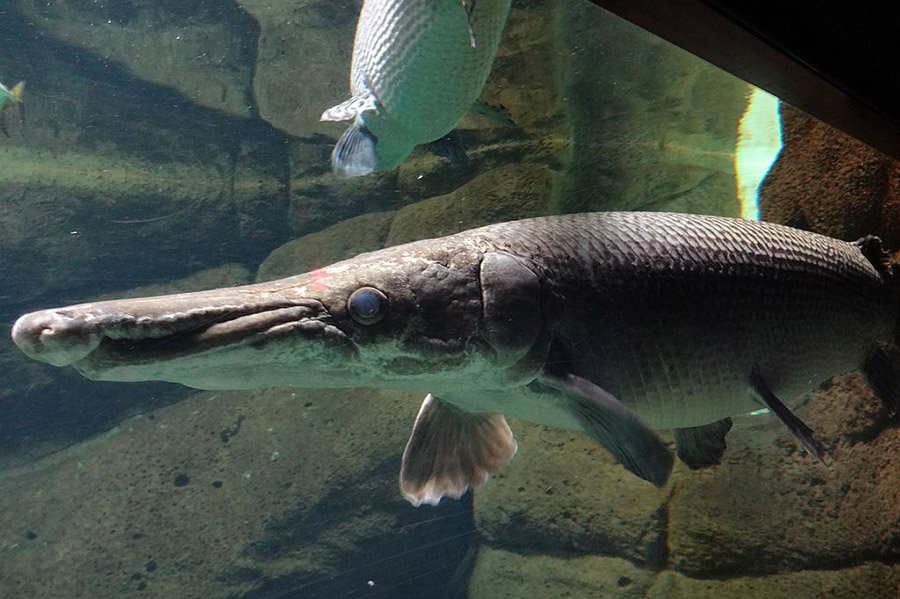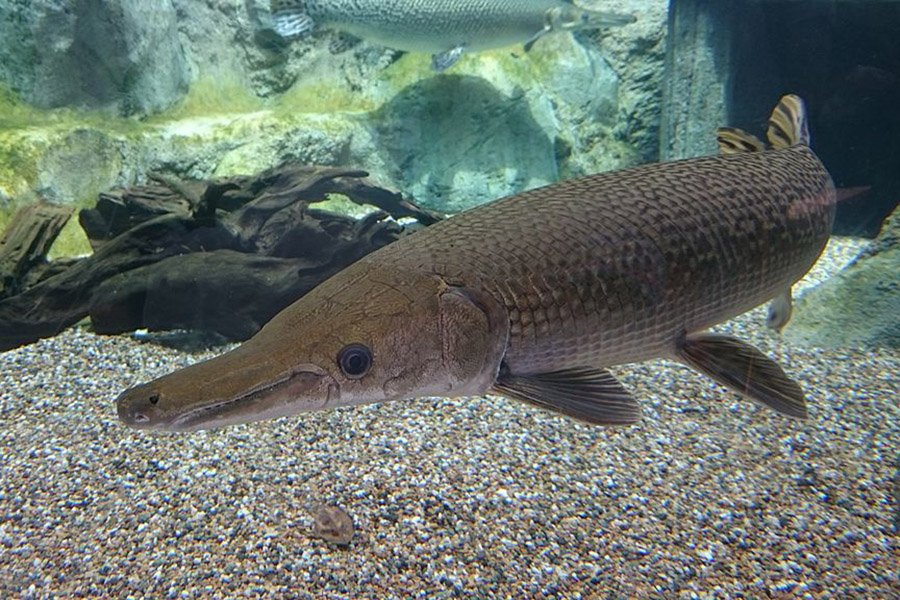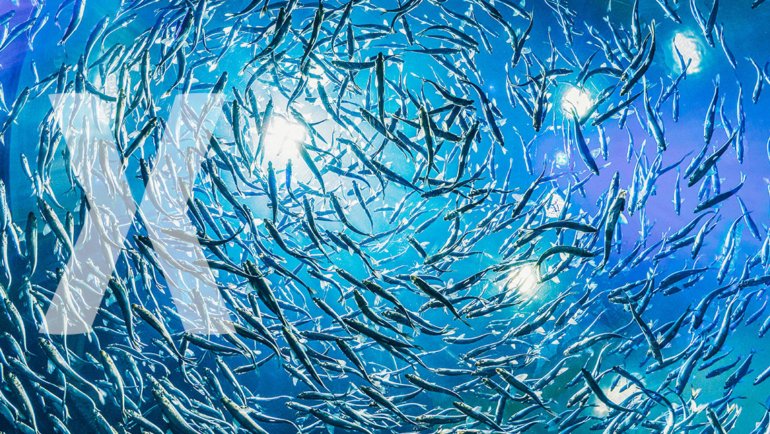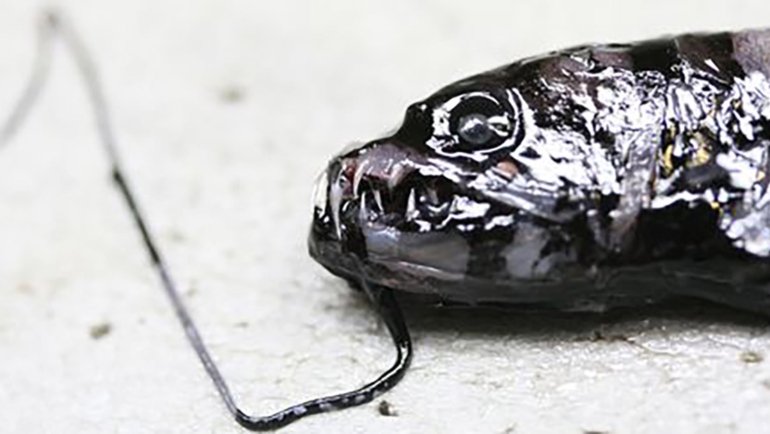The alligator gar, a fish with an ancient lineage and intimidating reputation, presents a fascinating study of resilience and adaptability.
Notorious for their broad snouts and double rows of sharp teeth that mirror those of alligators, these intriguing creatures serve an essential role in maintaining the health of their ecosystem.
In this article, we delve into the unique aspects of the alligator gar, offering insights into its lifestyle, habits, and conservation status.
The Alligator Gar at a Glance
Classification
| Kingdom: | Animalia |
| Phylum: | Chordata |
| Superclass: | Osteichthyes (Bony fish) |
| Class: | Actinopterygii |
| Order: | Lepisosteiformes |
| Family: | Lepisosteidae |
| Genus: | Atractosteus |
| Species: | A. spatula |
Essential Information
| Average Size: | 6.5 ft (2 m) – Maximum 10 ft (3 m) |
| Average Weight: | 100 lb (45 kg) – Maximum 327 lb (148 kg) |
| Average Lifespan: | 20 to 50 years |
| Geographical Range: | Southern and Midwestern United States, down into Mexico |
| Conservation Status: | Least Concern (IUCN Red List) |
Species and Subspecies
While the term “alligator gar” is frequently used to describe all species in the genus Atractosteus, there are actually several distinct species within this group, including the tropical gar (Atractosteus tropicus), the Cuban gar (Atractosteus tristoechus), and the alligator gar (Atractosteus spatula). The alligator gar is the largest of the species and is the primary focus of our article.
The key difference among these species is their size, with the alligator gar being notably larger than its relatives. Moreover, the alligator gar has a broader snout, similar to that of an alligator, hence its name.

Description
Alligator gars are unique and visually striking fish. They can grow up to 10 feet long (3 meters) and weigh as much as 327 pounds (148 kilograms), though averages are generally around 6.5 feet (2 meters) and 100 pounds (45 kilograms). They are renowned for their wide alligator-like snouts and sharp teeth set in double rows.
These fish have a row of large, hard, diamond-shaped scales covering their bodies. Their coloring is typically olive or gray on top, transitioning to a lighter white or yellow shade on their bellies.
Alligator gars do not show marked sexual dimorphism, meaning males and females have a similar appearance, but females tend to be larger than males.
Habitat and Distribution
The alligator gar is primarily found in the Southern United States, extending into parts of the Midwest and down into Mexico. They inhabit freshwater systems, including rivers, lakes, reservoirs, and bayous. They’ve even been spotted in brackish waters near the coast.
The alligator gar prefers slow-moving or stagnant waters with abundant vegetation, where they can hide and hunt. They’re often found lurking near the water’s surface, thanks to their unique ability to breathe both water and air, which allows them to survive in oxygen-depleted environments where other fish species can’t.

Behavior
Alligator gars are largely solitary creatures, although they have been known to form loose groups, particularly during the spawning season. They are primarily nocturnal, most active during the late evening and early morning hours.
Their ability to gulp air allows them to survive in low-oxygen environments and they can often be seen surfacing to breathe, especially in warmer temperatures.
Communication among alligator gars is not well-studied. However, like many fish, they are thought to use visual and chemical cues, particularly during spawning.
Diet and Hunting/Feeding Behavior
As apex predators, alligator gars primarily follow a carnivorous diet. They consume a variety of prey, including smaller fish, waterfowl, turtles, and small mammals that happen to be unlucky enough to cross their path.
The gar’s hunting strategy involves lurking among the vegetation near the water’s surface, lunging at unsuspecting prey with their powerful jaws and sharp teeth.
Alligator gars are also known to employ a sit-and-wait strategy, staying motionless in the water until prey comes within striking distance. Their teeth are designed to impale and hold onto struggling prey rather than to cut or tear, and they typically swallow their prey whole.
Predators
Young alligator gars, due to their smaller size, are susceptible to predation by larger fish, birds, and alligators. As adults, however, alligator gars have few natural predators, aside from humans.
Their tough, armored scales provide excellent protection from potential threats. Their size and predatory nature often place them at the top of the food chain in their aquatic habitats. Nevertheless, humans pose significant threats through hunting, habitat loss, and pollution.

Reproduction and Life Cycle
Alligator gars exhibit fascinating breeding habits. They usually spawn in the late spring and early summer when floodwaters inundate the coastal marshes and floodplains, creating ideal breeding conditions.
Males often court multiple females, with females laying eggs that are then fertilized externally by the males. Females are capable of producing a large number of eggs, sometimes up to several thousand in a single spawning season.
The incubation period for the fertilized eggs is typically only a few days, after which the larvae hatch. Interestingly, the newly hatched gars come equipped with an adhesive disc on their snouts, which they use to attach to vegetation during their first few days of life, after which they become free-swimming.
Alligator gars have a relatively slow growth rate and are believed to have a long lifespan, with some reports suggesting they may live up to 50 years or more.
Conservation and Threats
The conservation status of the alligator gar is currently listed as “Least Concern” by the IUCN Red List. However, the species has been greatly reduced in some parts of its range and extirpated in others, largely due to habitat loss, pollution, and overfishing.
In the past, alligator gars were often killed due to a misconception that they were harmful to sport fish populations, but recent research suggests that they actually play a beneficial role in aquatic ecosystems, helping to control populations of invasive species.
Efforts are now underway in many areas to conserve and restore alligator gar populations. These include habitat protection and restoration projects, research programs, and regulations on gar fishing. In some states, reintroduction programs have been implemented to help restore the alligator gar to waters from which it had been eliminated.
Fun Facts
- Despite their fearsome appearance, alligator gars are not aggressive towards humans and attacks are extremely rare.
- The alligator gar’s eggs are poisonous to humans, birds, and other mammals if ingested.
- Alligator gars are among the largest freshwater fishes in North America, capable of growing up to 10 feet long and weighing over 300 pounds.
- The “alligator” in their name refers to their broad snouts, which are similar to those of alligators, and to their double row of sharp, conical teeth in the upper jaw.
- Their scales are so hard and tough that Native Americans once used them as arrowheads.
Frequently Asked Questions
What do alligator gars eat?
Alligator gars are opportunistic carnivores and primarily feed on fish, but they will also eat waterfowl, turtles, and small mammals when given the opportunity.
Are alligator gars dangerous to humans?
Despite their fearsome appearance, alligator gars pose little threat to humans. While they are capable of delivering a powerful bite, attacks on humans are extremely rare.
How big can alligator gars get?
Alligator gars are one of the largest freshwater fish species in North America. They can grow up to 10 feet long and weigh over 300 pounds.
What’s the lifespan of an alligator gar?
Alligator gars are believed to live for 50 years or more, but there have been reports of some individuals living for up to 70 years.
What are the main threats to alligator gars?
The main threats to alligator gars include habitat loss due to drainage of wetlands and river channelization, pollution, and overfishing. In the past, they were often killed due to a misconception that they were harmful to sport fish populations.





